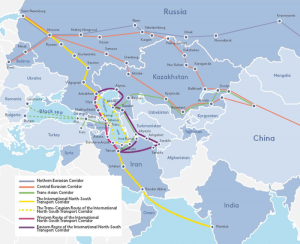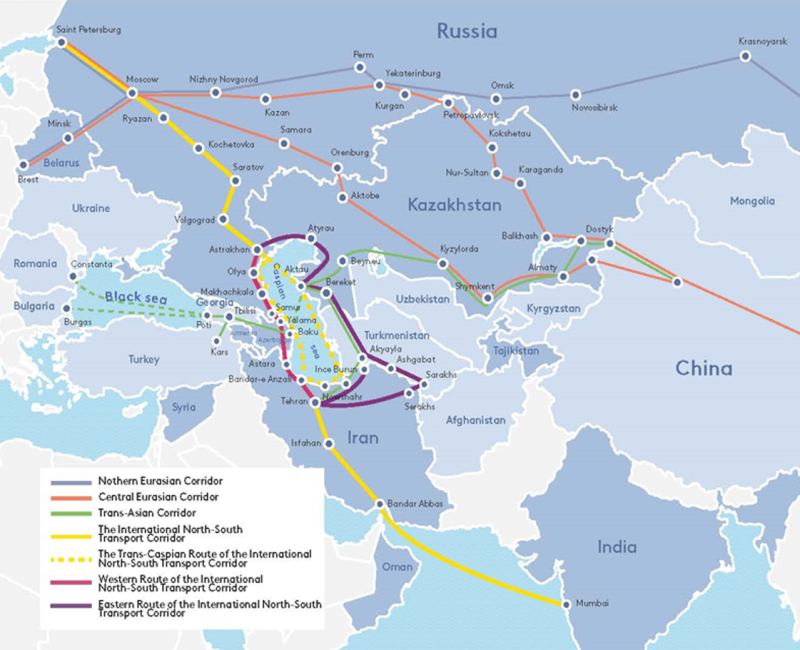What is the INSTC Corridor?
The International North-South Transport Corridor (INSTC) is a 7,200-kilometer-long (4,500-mile) multi-modal transport network connecting India, Iran, Russia, Central Asia, and Europe through ship, rail, and road routes. Designed to facilitate freight movement between the North and South, this corridor presents a strategic alternative to the traditional maritime route via the Suez Canal, significantly reducing time and cost.
Which Countries Are Part of the INSTC Corridor?
The INSTC connects multiple countries across Asia and Europe. The core countries actively participating in this corridor include:
- India
- Iran
- Russia
- Azerbaijan
- Armenia
- Turkmenistan
- Kazakhstan
- Belarus
- Georgia
- Uzbekistan
- Pakistan
- Oman
- Bulgaria
- Turkey
Other regional players and observer states are gradually integrating or expressing interest in the route.
Route Details: From Mumbai to Moscow
The corridor stretches from Mumbai, India in the south to Moscow, Russia in the north. It utilizes the following key segments:
- Maritime Leg: Mumbai to Persian Gulf – specifically Bandar Abbas (Iran)
- Rail and Road: Bandar Abbas through Iran to the Caspian Sea
- Caspian Sea Leg: Via ports such as Anzali and Astrakhan
- Northern Rail Links: Russia to Europe via St. Petersburg and beyond

This integrated route connects Indian Ocean ports to Northern Europe via Iranian land and Russian rail networks.
What is the Significance of the INSTC Corridor?
The INSTC offers strategic and economic benefits:
- Faster transit: Reduces shipping time by 30–40% compared to the Suez Canal route.
- Cost-efficient: Estimated to cut costs by 20–25%.
- Geopolitical balance: Provides a non-Western trade route alternative amid rising global tensions.
- Regional connectivity: Strengthens trade ties between India, Iran, Russia, and Central Asia.
- Boost to Chabahar and Caspian ports: Critical for maritime logistics.
What Are the Issues with the INSTC?
Despite its promise, INSTC faces several challenges:
- Geopolitical Instability: Sanctions on Iran and Russia complicate trade flows.
- Infrastructure Gaps: Rail and road systems in some segments remain underdeveloped.
- Bureaucratic Hurdles: Customs, documentation, and logistics coordination between diverse nations are still being harmonized.
- Security Risks: Some regions face concerns over political unrest and safe transit.
INSTC vs. Other Trade Corridors
Many users search for comparisons like “INSTC vs. IMEC corridor” or “East-West Corridor vs. North-South Corridor.” Here’s how INSTC stands out:
- IMEC (India-Middle East-Europe Corridor): Focuses on linking India to Europe via the Arabian Peninsula.
- East-West Corridor: Traditionally links China with Europe via Central Asia and Russia.
- INSTC: Uniquely connects South Asia to Europe through Iran and Russia, serving as a sanctions-free, non-Western route.
What is the Current Status of the INSTC?
The INSTC has seen significant progress:
- India and Iran’s Chabahar Port is operational.
- Astara Port in Azerbaijan has been upgraded.
- Russia has started shipping goods via this corridor post-2022 sanctions.
- Digital customs systems and unified tariffs are being negotiated among member states.
Yet, full-scale integration remains a work in progress.
North and South Ends of INSTC
- North End: Moscow, Russian Federation – from where goods can move into the wider European market.
- South End: Mumbai, India – a critical hub for exporting goods from South Asia.
This alignment enhances Eurasian trade and promotes a balanced global supply chain.
The INSTC and Maritime Education
Understanding the INSTC corridor is increasingly important in maritime education and logistics training, as it reshapes global freight flows. Cadets and professionals should study its:
- Port logistics
- Intermodal transport integration
- International maritime law
- Regional geopolitics and economics
Most Frequent Questions & Keywords About the INSTC Corridor (FAQ)
1. What is the International North-South Transport Corridor (INSTC)?
The INSTC is a 7,200-km multi-modal trade route connecting India, Iran, Russia, and Europe via ship, rail, and road. It serves as a faster, cheaper alternative to the Suez Canal route, cutting transit time by 40% and costs by 30%.
2. When was the INSTC established?
The corridor was formally agreed upon in 2000 by India, Iran, and Russia during the Euro-Asian Transport Conference. However, full implementation has been gradual due to geopolitical and infrastructure challenges.
3. What are the key objectives of the INSTC?
✔ Boost trade efficiency between South Asia, Central Asia, Russia, and Europe.
✔ Reduce dependency on the Suez Canal, avoiding congestion and high fees.
✔ Strengthen regional economic integration, supporting the Eurasian Economic Union (EAEU).
✔ Enhance India’s connectivity to Afghanistan, Central Asia, and Europe without relying on Pakistan.
4. Which countries are part of the INSTC?
The 13 member nations include:
- Core members: India, Iran, Russia, Azerbaijan
- Other participants: Armenia, Belarus, Kazakhstan, Kyrgyzstan, Tajikistan, Oman, Turkey, Syria, Ukraine
5. How does the INSTC benefit India?
✔ Faster trade access to Russia and Europe (via Iran & Azerbaijan).
✔ Alternative to China’s Belt and Road Initiative (BRI), reducing geopolitical reliance.
✔ Integration with Chabahar Port, bypassing Pakistan for Afghanistan trade.
✔ Strategic leverage in Central Asia and energy security via Iran.
6. What are the major challenges facing the INSTC?
⚠ Geopolitical tensions (e.g., Iran sanctions, Russia-Ukraine war).
⚠ Infrastructure gaps in Central Asia and Caucasus regions.
⚠ Lack of uniform customs & logistics standards across member states.
⚠ Competition from China’s BRI and Middle Corridor (TITR).
7. How is the INSTC different from the Suez Canal route?
| Factor | INSTC Route | Suez Canal Route |
|---|---|---|
| Transit Time | ~20-25 days (India-Russia) | ~40-60 days |
| Cost | 30% cheaper | Higher fees & congestion delays |
| Route Flexibility | Multi-modal (ship, rail, road) | Primarily maritime |
Conclusion
The International North–South Transport Corridor (INSTC) represents a bold step toward redefining global logistics. Despite geopolitical and infrastructural hurdles, its ability to reduce costs, enhance trade connectivity, and offer an alternative to traditional routes makes it a vital part of the modern transport network.
As India, Iran, and Russia deepen their cooperation, and Central Asia’s role in global trade expands, the INSTC is set to become a pillar of 21st-century supply chains. Maritime students and professionals must stay updated on this corridor’s evolution, as it holds profound implications for global commerce and maritime strategy.
Most Helpful Resources to Study the INSTC Corridor
1. Testbook – Comprehensive INSTC Overview
📌 Covers routes, economic benefits, challenges, and future prospects of the corridor.
2. NEXT IAS – INSTC Editorial Analysis
📌 Examines India’s strategic interests and comparison with China’s BRI.
3. SSB Crack – INSTC Explained
📌 Discusses Chabahar Port integration, sanctions impact, and recent developments.
4. Forum IAS – INSTC’s Strategic Value for India
📌 Analyzes how INSTC fits into India’s multi-alignment foreign policy.
5. ClearIAS Video on INSTC
🎥 Visual breakdown of trade routes, cost savings, and geopolitical implications.
6. ORF – Geopolitical Impact of INSTC
📌 Explores how INSTC reshapes Eurasia’s trade dynamics.
7. The Diplomat – INSTC vs BRI
📌 Compares China’s Belt and Road with INSTC’s regional influence.
Key Search Terms: INSTC route map, INSTC vs Suez Canal, India-Russia trade via INSTC, Chabahar Port INSTC, INSTC latest updates, INSTC challenges, INSTC member countries, INSTC UPSC
Explore resources like those below from maritimeducation.com :
Persian Gulf and Iran’s Strategic Role in the International North-South Transport Corridor (INSTC)

